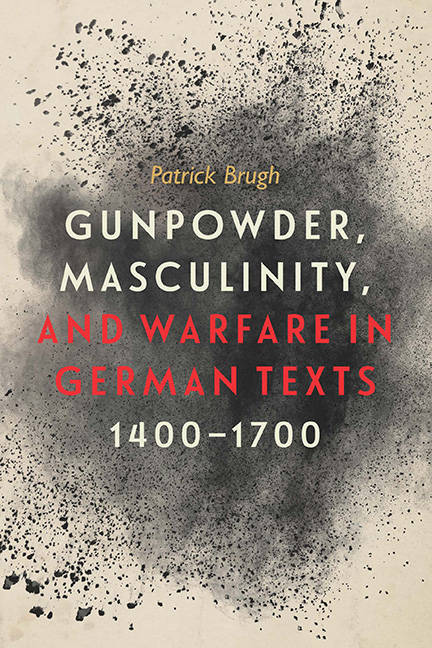Book contents
- Frontmatter
- Dedication
- Contents
- List of Illustrations
- Acknowledgments
- A Note on Translation and Spelling
- Abbreviations
- 1 A Tale of Two Suits of Armor
- 2 Of Hussites and Haystacks, of Questions and Cannons
- 3 Textbook War: The Genealogy of Kriegsbücher
- 4 Gunpowder Dilemmas and Loaded Peace in Fronsperger's Kriegsbuch
- 5 Depicting Gunpowder in German Military Broadsheets (1630–32)
- 6 Gustav Adolf's Gunpowder Demise
- 7 The Aesthetics of Gunpowder in Seventeenth-Century German War Novels
- 8 Cavalier Endings in Happel's Der insulanische Mandorell (1682)
- Appendix: Comparisons of Broadsheets from Battles of Breitenfeld, Rain am Lech, and Lützen
- Notes
- Bibliography
- Index
2 - Of Hussites and Haystacks, of Questions and Cannons
Published online by Cambridge University Press: 25 March 2020
- Frontmatter
- Dedication
- Contents
- List of Illustrations
- Acknowledgments
- A Note on Translation and Spelling
- Abbreviations
- 1 A Tale of Two Suits of Armor
- 2 Of Hussites and Haystacks, of Questions and Cannons
- 3 Textbook War: The Genealogy of Kriegsbücher
- 4 Gunpowder Dilemmas and Loaded Peace in Fronsperger's Kriegsbuch
- 5 Depicting Gunpowder in German Military Broadsheets (1630–32)
- 6 Gustav Adolf's Gunpowder Demise
- 7 The Aesthetics of Gunpowder in Seventeenth-Century German War Novels
- 8 Cavalier Endings in Happel's Der insulanische Mandorell (1682)
- Appendix: Comparisons of Broadsheets from Battles of Breitenfeld, Rain am Lech, and Lützen
- Notes
- Bibliography
- Index
Summary
And a rare powder; next a flame applies
To a small hole which scarcely can be seen,
As the physician does cauterize
And seal the severed ending of a vein.
Ejected by explosion, the ball flies
With a loud noise, so that men think there's been
A might tempest in which thunder crashes
And everywhere the lightning burns and flashes.
— Ludovico Ariosto, Orlando FuriosoHussites and Cannons: A New Way of Fighting
The Council of Constance was not a timid affair. During the four years it lasted, tens of thousands of visitors flooded the prosperous German town that sits on the banks of the Rhine where it flows northward out of the clear, Alpine waters of Lake Constance. The human influx put pressure on the city's available services and sleeping quarters and brought political upheaval to Europe that would be felt for centuries to come. In 1414 and 1415 alone, the Council formally deposed Pope John XXIII (r. 1410–15), as well as imprisoned and then executed Jan Hus (ca. 1369–1415), namesake of the fifteenth-century Czech religious reform movement: Hussitism.
Hus had traveled to Constance under King Sigismund's (b. 1368, r. 1410–37) seal of safe passage and safe return, but it did him little good. He was thrown into a monastery dungeon shortly after he arrived in November 3, 1414, and then fell ill. On July 6, 1415, after an unsuccessful effort to defend his teachings, Hus was defrocked in the cathedral by church authorities, handed over to temporal authorities, led to a pile of his burning books, tied to a stake, and then burned alive in front of a crowd of more than 3,000 people.1 The bones that remained were smashed and his ashes and mortal scraps tossed into the Rhine. His followers in Bohemia did not take the auspicious message lightly. The violent death of Hus and desecration of his remains ignited the Hussite Revolution, a conflict of European dimensions that involved political and military correspondence across much of the continent. During the Hussite Wars of Bohemia, between 1419 and 1442, gunpowder would play its first politically decisive role since arriving in Europe a century earlier. It would still be another 100 years, however, before the Italian Wars crowned firearms—both artillery and shoulder arms—as de facto components of the European battlefield.
- Type
- Chapter
- Information
- Publisher: Boydell & BrewerPrint publication year: 2019



